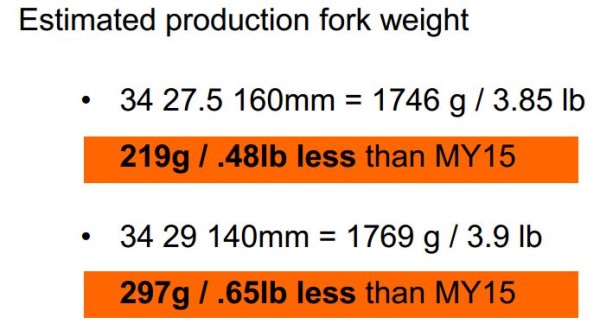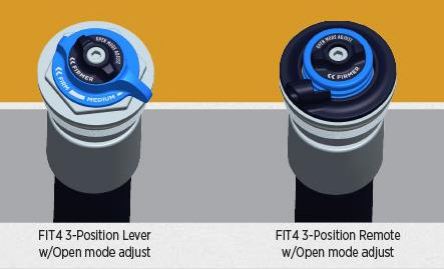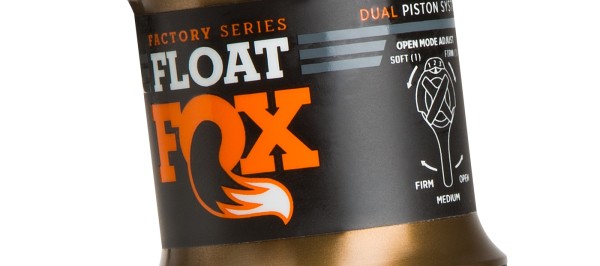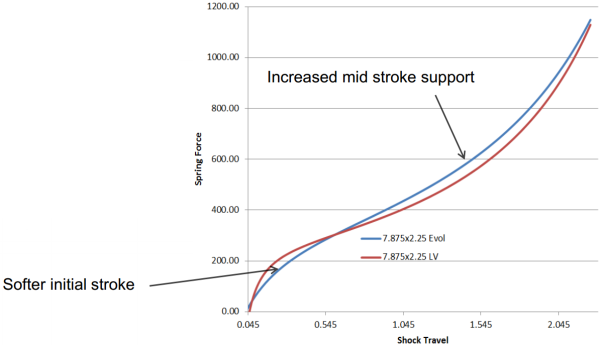 Last year Fox introduced a completely revised 36 series of forks that were lighter and more supple than anything else in their lineup. An important part of that trail taming recipe was a move to a new air spring system, which eliminated the use of a coil in the negative spring.
Last year Fox introduced a completely revised 36 series of forks that were lighter and more supple than anything else in their lineup. An important part of that trail taming recipe was a move to a new air spring system, which eliminated the use of a coil in the negative spring.
In addition to helping shave almost a quarter pound, the new design (which they’re calling the FIT4 in the 34 series fork, for fourth generation Fox Isolated Technology) provided a more consistent feel. Rather than having to pick a coil spring rate to accommodate a wide variety of riders, they borrowed from a design first introduced in their 1999 Float Shock, to automatically equalize the air in the negative chamber when the fork was deep into it’s compression stroke. This technology also meant that Fox could introduce volume spacers to tune the progressiveness of the air spring. (You can read more about the new Float air spring here, and check out our Suspension Setup Series to learn more in general.)
Due to the drastic drop in weight and incredible gains in performance, it was only a matter of time before Fox took this technology down market to its 34 series of trail oriented forks. As such, Fox claims the new 34 is the “little brother to the 36” and is aimed at aggressive trail riders looking for a super lightweight package.  How light? They’re claiming the new 27.5″ model will be nearly half a pound lighter than the previous model, and the 29″ will be .65 lbs less. They will not be offering a 26″ version of this fork (although a 36 with a straight steer for 26″ wheels is still available).
How light? They’re claiming the new 27.5″ model will be nearly half a pound lighter than the previous model, and the 29″ will be .65 lbs less. They will not be offering a 26″ version of this fork (although a 36 with a straight steer for 26″ wheels is still available).
In addition to the weight saved from going to the new air spring, further weight savings come from completely new lowers, uppers, crown, and steerer tube. 
The new product line also moves away from the reviled CTD adjustment nomenclature, to a new 3-position on-the-fly system. The new settings are called Open, Medium, and Firm, and there are 22 clicks of “wide range” low speed compression in the Open mode. Retail for the new 34 Float Fit4 Fork is $875.
Out back, Fox has also updated their Float series with their new line of DPS shocks. This new shock has a dual piston valve design that offers a firmer climbing platform. Like the fork, the shock does away with the CTD settings in favor of the new Open, Medium, and Firm settings.
They’ve also introduced a new air sleeve dubbed the EVOL (which has a similar outward appearance to the Vorspring Corset Air Spring, but has different internal functions, and will produce different results), which has an increased negative air volume for a softer initial stroke, increased mid stroke support, and more linear spring curve. Retail for the new Float DPS shock is $450.
TECHNICAL Q&A
Despite being busy with a major press launch and preparing for Sea Otter, Fox’s Global Communications Manager Mark Jordan was kind enough to work with the Fox engineering team to answer a few questions. We have a meeting with him scheduled for Sea Otter, so please leave any additional technical questions in the comments, and we’ll get them answered.
BIKERUMOR: Where do all the weight savings come from? The 34 chassis is completely new, including the lowers, upper tubes, crown, steer tube, etc. Compared to MY15, the MY16 34-series forks save weight in the following places: 34 27.5 WEIGHT SAVINGS*
- Steerer 29g
- Crown 30g
- Upper Tubes 14g
- Lower Leg 56g
- FLOAT Air spring 90g
- Total weight savings vs MY15 34: 219g / .48lb
- Estimated fork weight (160mm travel): 1746g / 3.85lb
34 29 WEIGHT SAVINGS*
- Steerer 34g
- Crown 31g
- Upper Tubes 53g
- Lower Leg 49g
- FLOAT Air Spring 130g
- Total weight savings vs MY15 34: 297g / .65lb
- Estimated fork weight (140mm travel): 1769g / 3.9lb
*Weights are approximate based on pre-production forks
BIKERUMOR: How is the open-medium-firm FIT4 damper different from CTD? The FIT4 damper uses architecture from the RC2 damper found in the 36 and 40, featuring a 10mm shaft and seal head design that increases oil flow to the base valve. We improved the flow path design in the base valve for the three compression damping positions to provide more adjustment, sensitivity and control. We also increased flow through the rebound circuit for faster recovery from deep stroke hits.
BIKERUMOR: Is the larger 10mm damper shaft Kashima coated? Is anything being done to counter the extra drag of a larger shaft? The shaft is hard anodized. The MY16 34 benefits from all of the friction reduction we did in 2015 – new upper tube finish, 20 Wt Gold lubrication oil and updated seals – as well as the updated seal head design from the RC2 damper. BIKERUMOR: The previous fork air spring used a main chamber, a main chamber seal, and a coil negative spring. The new fork spring uses a main chamber, main chamber seal, negative air spring, negative air spring seal, and transfer port. How did you make this new spring with more seals, have LESS friction than the simpler old design? In the ’16 34 FLOAT air spring, the main chamber seal also seals the negative air spring, just like our rear shocks, so there is just one seal. Compared to the 36 air spring, the 34 FLOAT air spring is lighter and uses one less seal. On the 36, the transfer port was on the shaft, allowing travel changing with spacers and re-positioning the shaft height. On the 34, we’ve removed the shaft and need for a seal to make it lighter and now the transfer port is on the upper tube- just like our FLOAT shocks. In addition, the 34 uses volume spacers similar to the 36 to regulate the progressiveness of the air spring curve.
BIKERUMOR: The previous fork air spring used a main chamber, a main chamber seal, and a coil negative spring. The new fork spring uses a main chamber, main chamber seal, negative air spring, negative air spring seal, and transfer port. How did you make this new spring with more seals, have LESS friction than the simpler old design? In the ’16 34 FLOAT air spring, the main chamber seal also seals the negative air spring, just like our rear shocks, so there is just one seal. Compared to the 36 air spring, the 34 FLOAT air spring is lighter and uses one less seal. On the 36, the transfer port was on the shaft, allowing travel changing with spacers and re-positioning the shaft height. On the 34, we’ve removed the shaft and need for a seal to make it lighter and now the transfer port is on the upper tube- just like our FLOAT shocks. In addition, the 34 uses volume spacers similar to the 36 to regulate the progressiveness of the air spring curve.
BIKERUMOR: The old air spring had a main air chamber, and did not significantly use the compression of the air in the fork lowers. Now, with the addition of the negative air chamber, the displacement of the stanchion tube into the lowers more significantly compresses the air in the fork lowers. How does that affect the spring curve? This is something that we’ve addressed with air bleed ports on the 40 but internal pressure in the lower legs is significantly reduced with the smaller upper tube diameters.
BIKERUMOR: Is the axle-to-crown of the new 34 similar to the 36, or even lower? The will be pretty much the same.
 BIKERUMOR: How is the three position lever on the shock different from CTD? At the lever, the main difference is the black batwing knob regulates the compression in the Open Mode. Internally, the Dual Piston System is very different. DPS has five damping circuits – high- and low-speed rebound and compression, and a lockout. The valve design allows us to separate the low- and high-speed compression circuits from our lockout circuit, while maintaining check flow for compression and rebound. Basically, that means we can separately tune the compression and rebound circuits without affecting the lockout, and vice versa.
BIKERUMOR: How is the three position lever on the shock different from CTD? At the lever, the main difference is the black batwing knob regulates the compression in the Open Mode. Internally, the Dual Piston System is very different. DPS has five damping circuits – high- and low-speed rebound and compression, and a lockout. The valve design allows us to separate the low- and high-speed compression circuits from our lockout circuit, while maintaining check flow for compression and rebound. Basically, that means we can separately tune the compression and rebound circuits without affecting the lockout, and vice versa.
BIKERUMOR: What safety measures are there to prevent people from damaging the shock if they descend with lockout on? Is there a safety blowoff valve integrated? The lockout has a blowoff if a rider accidentally leaves the fork/shock in the Firm Mode on a descent.
BIKERUMOR: Will the EVOL be available as an after market upgrade?
The EVOL air can is only available on 2016 product right now because the damping tune needs to match the character of the air spring.
We will be selling EVOL air sleeves aftermarket for earlier model shocks, although we not have pricing available yet. (Updated April 1st)

